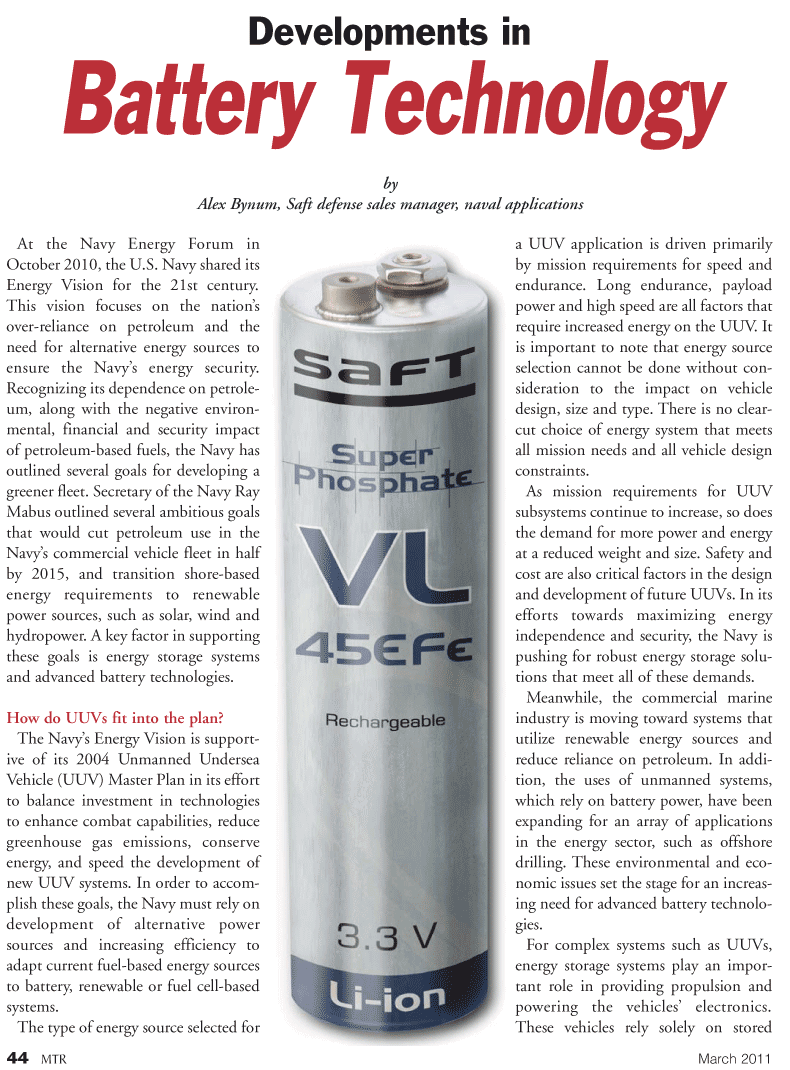
Page 44: of Marine Technology Magazine (March 2011)
Subsea Vehicles: AUV, ROV, UUV Annual
Read this page in Pdf, Flash or Html5 edition of March 2011 Marine Technology Magazine
At the Navy Energy Forum in
October 2010, the U.S. Navy shared its
Energy Vision for the 21st century.
This vision focuses on the nation’s over-reliance on petroleum and the need for alternative energy sources to ensure the Navy’s energy security.
Recognizing its dependence on petrole- um, along with the negative environ- mental, financial and security impact of petroleum-based fuels, the Navy has outlined several goals for developing a greener fleet. Secretary of the Navy Ray
Mabus outlined several ambitious goals that would cut petroleum use in the
Navy’s commercial vehicle fleet in half by 2015, and transition shore-based energy requirements to renewable power sources, such as solar, wind and hydropower. A key factor in supporting these goals is energy storage systems and advanced battery technologies.
How do UUVs fit into the plan?
The Navy’s Energy Vision is support- ive of its 2004 Unmanned Undersea
Vehicle (UUV) Master Plan in its effort to balance investment in technologies to enhance combat capabilities, reduce greenhouse gas emissions, conserve energy, and speed the development of new UUV systems. In order to accom- plish these goals, the Navy must rely on development of alternative power sources and increasing efficiency to adapt current fuel-based energy sources to battery, renewable or fuel cell-based systems.
The type of energy source selected for a UUV application is driven primarily by mission requirements for speed and endurance. Long endurance, payload power and high speed are all factors that require increased energy on the UUV. It is important to note that energy source selection cannot be done without con- sideration to the impact on vehicle design, size and type. There is no clear- cut choice of energy system that meets all mission needs and all vehicle design constraints.
As mission requirements for UUV subsystems continue to increase, so does the demand for more power and energy at a reduced weight and size. Safety and cost are also critical factors in the design and development of future UUVs. In its efforts towards maximizing energy independence and security, the Navy is pushing for robust energy storage solu- tions that meet all of these demands.
Meanwhile, the commercial marine industry is moving toward systems that utilize renewable energy sources and reduce reliance on petroleum. In addi- tion, the uses of unmanned systems, which rely on battery power, have been expanding for an array of applications in the energy sector, such as offshore drilling. These environmental and eco- nomic issues set the stage for an increas- ing need for advanced battery technolo- gies.
For complex systems such as UUVs, energy storage systems play an impor- tant role in providing propulsion and powering the vehicles’ electronics.
These vehicles rely solely on stored
Developments in
Battery Technology by
Alex Bynum, Saft defense sales manager, naval applications 44 MTR March 2011

 43
43

 45
45
